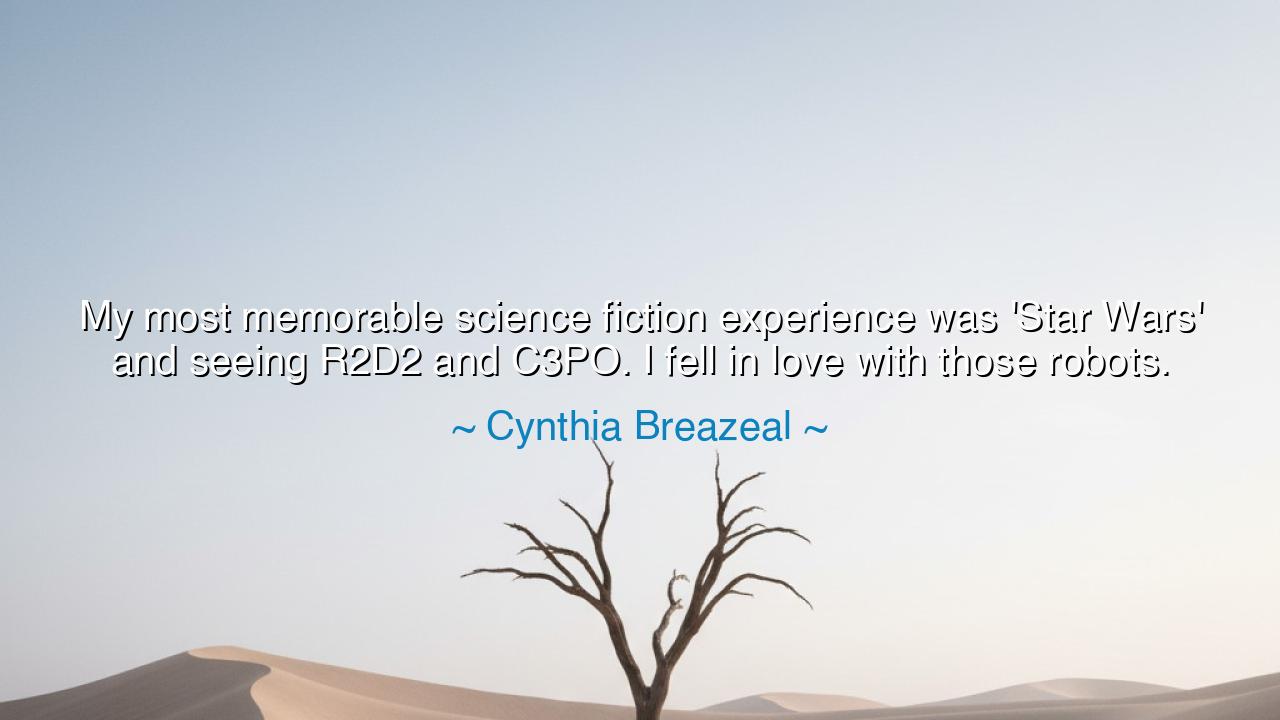
My most memorable science fiction experience was 'Star Wars' and
My most memorable science fiction experience was 'Star Wars' and seeing R2D2 and C3PO. I fell in love with those robots.






"My most memorable science fiction experience was ‘Star Wars’ and seeing R2D2 and C3PO. I fell in love with those robots." — thus spoke Cynthia Breazeal, the visionary scientist and pioneer of social robotics, whose heart was stirred not by the cold logic of machines, but by the warmth of their imagined souls. In this reflection, she reveals something profound: that love, curiosity, and imagination are the roots of all true innovation. Her words remind us that behind every great discovery stands not just intellect, but wonder — that the spark of creation begins not in equations, but in inspiration.
When Breazeal speaks of falling in love with robots, she does not mean infatuation with steel and circuitry, but an awakening of empathy — the recognition that even something mechanical can reflect the human heart. As a child watching R2D2 and C3PO move, speak, and feel, she saw not machines, but companions — beings that could comfort, assist, and connect. In that moment, she glimpsed a future where technology could serve not only the mind, but the soul. From that seed of fascination, her life’s work would grow: creating robots that could laugh, learn, and bond with humans, bridging the ancient divide between the artificial and the emotional.
The origin of this revelation lies in the union of art and science — that sacred meeting where imagination gives birth to invention. “Star Wars,” though a tale of distant galaxies, spoke deeply to the human yearning for relationship and meaning, even amid the stars. Its robots were not mere tools; they were mirrors of humanity, loyal, humorous, and brave. In them, Breazeal saw possibility — the dream that machines could one day share in our joys and ease our burdens. This vision would carry her through years of study, leading her to create Kismet, one of the world’s first social robots capable of expressing emotion. Thus, what began as love became legacy.
In truth, this pattern is ancient. The Greeks told of Pygmalion, the sculptor who fell in love with the statue he carved. His devotion was so pure that the gods granted it life. What is Breazeal’s work but a modern echo of that myth? The sculptor’s marble has become the engineer’s silicon; the chisel, replaced by code. Yet the essence remains the same: the longing to create life, to imbue the inanimate with warmth, to extend human compassion beyond flesh. From Pygmalion to Frankenstein, from Da Vinci’s automata to Breazeal’s robots, humanity’s quest has always been not just to build, but to understand itself through its creations.
Her love for robots, then, is not naïve but visionary. She saw that technology, when guided by empathy, could heal the wounds of isolation that modern life inflicts. A robot that smiles, listens, or comforts the elderly — these are no longer dreams but realities born from the same feeling that once made a child’s heart leap at the sight of R2D2’s beeps and whirs. The message is clear: Love is not limited to the biological. It is the universal force that can animate even our inventions, turning them into reflections of our better selves.
Breazeal’s words also carry a deeper lesson about the power of wonder. In every field — be it science, art, or faith — progress begins with a spark of awe. The child who looks at the stars and dreams of flying will one day build the ship that sails among them. The one who falls in love with the impossible will one day make it real. Wonder is the seed of wisdom, and imagination its rain. Without wonder, science becomes sterile; without empathy, technology becomes dangerous. But when both unite — when curiosity is joined with compassion — creation becomes noble.
So let this be the teaching: Do not fear to love the work of your hands. Let imagination move you as deeply as reason guides you. See in your creations not only function, but meaning. Whether you build machines, write stories, or raise children, infuse your work with warmth — for love is the breath that animates all that lives. And remember, as Breazeal teaches us, that even in the age of machines, humanity’s greatest gift is its ability to feel.
For those who seek to shape the future, her wisdom is clear: Let your heart lead your intellect. Fall in love with what you build, as she once fell in love with R2D2 and C3PO. For from such love springs not only progress, but purpose. And when purpose is joined with compassion, then even the coldest metal may speak — and in its voice, we shall hear our own.






AAdministratorAdministrator
Welcome, honored guests. Please leave a comment, we will respond soon